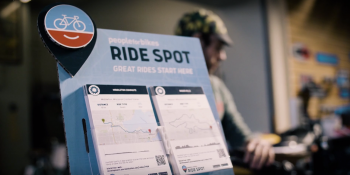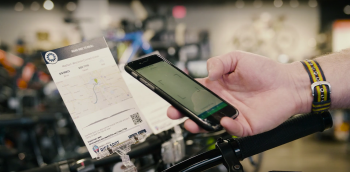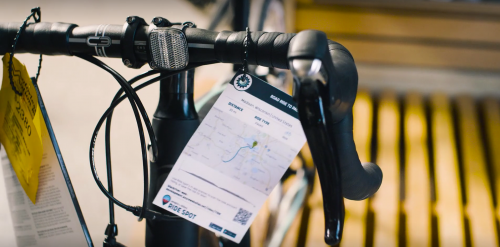BOULDER, Colo. (BRAIN) — More than two years and more than a million dollars in development, PeopleForBikes’ Ride Spot mobile app was unveiled at April’s Bicycle Leadership Conference and is being rolled out in 30 cities this year.
Instead of crowdsourced maps like Strava and other map apps, Ride Spot offers hand-picked routes in each community, chosen by local bike retailers or other organizations. The routes give beginners an on-ramp to cycling, helping the industry and retailers establish a relationship with the riders that continues after they wheel new bikes out the door.
Ride Spot also has features that help bike retailers increase local riding participation, and develop — and market to — a riding community with their store as a hub. It’s all about serving up the experience, not just the hardware, said PeopleForBikes’ president Tim Blumenthal.
“Some people think we’re just about infrastructure, but we are also about getting people out and using that infrastructure,” he said.
An earlier version of the app was called Blackriver, developed by Trek’s former global creative director, Eric Lynn. Lynn now directs the Ride Spot project for PeopleForBikes.
Blumenthal said Blackriver had invested “seven-figures” into the app before PeopleForBikes took it over and invested another $1 million-plus in its development.
The app project, initially called Ride Guide, was inspired by the 20 Collective program, a retailer panel organized by Shimano. The group had proposed a “Got milk?”-style campaign for cycling, but decided the industry lacked the resources. BRAIN wrote about the app last spring when it was still called Ride Guide.
Ride Spot is deeply dependent on retailer participation, and to give value to store owners it offers marketing tools not available from other social or mapping platforms.
Stores are tasked with developing “classic” local rides on the app. Then they can have map/cue sheet cards printed to give to customers. The cue sheets can even be in the form of tags that can be hung from showroom bikes, suggesting a ride that would be ideal for that model. The cue sheets have a QR code that riders can scan to open the route in the Ride Spot app if they prefer.
PeopleForBikes is making counter and slat wall displays that hold the cue cards available to participating retailers. Retailers can get custom cards printed at a discount through the platform.
The retailer commitment includes mapping about 10 classic rides, with a couple paragraphs of introduction and photos for each. It can also build out its shop profile in the app. Ride Spot may work with multiple retailers in the same area but “Premium” retailers, for $700 a year, get a more noticeable red pin on the Ride Spot map, in addition to other features.
Shops also can schedule events through the app, and build challenges, like riding a certain number of days per month, with a small prize or recognition on competition. They can customize the challenge parameters in the app, and riders who join a challenge or register for an event share their email and other data, allowing retailers and PeopleForBikes to build a marketing database.
Some supplier partners will be encouraging their retailers to join and may make co-op dollars available. Suppliers also are enlisting sponsored athletes and ambassadors to add their favorite rides.
Early testers include the organizers of the Dirty Kanza, who are using the app to create challenges on the racecourse, encouraging regional riders to ride sections all year, with rewards from local retailers and others.
QBP’s Surly brand also is working with six retailers on a trial program using the app.
The program will roll out in three stages to 30 markets this summer.
“We are in population mode now; we are content building,” Lynn said in May. “We will start pushing this out to consumers in mid-July.”




